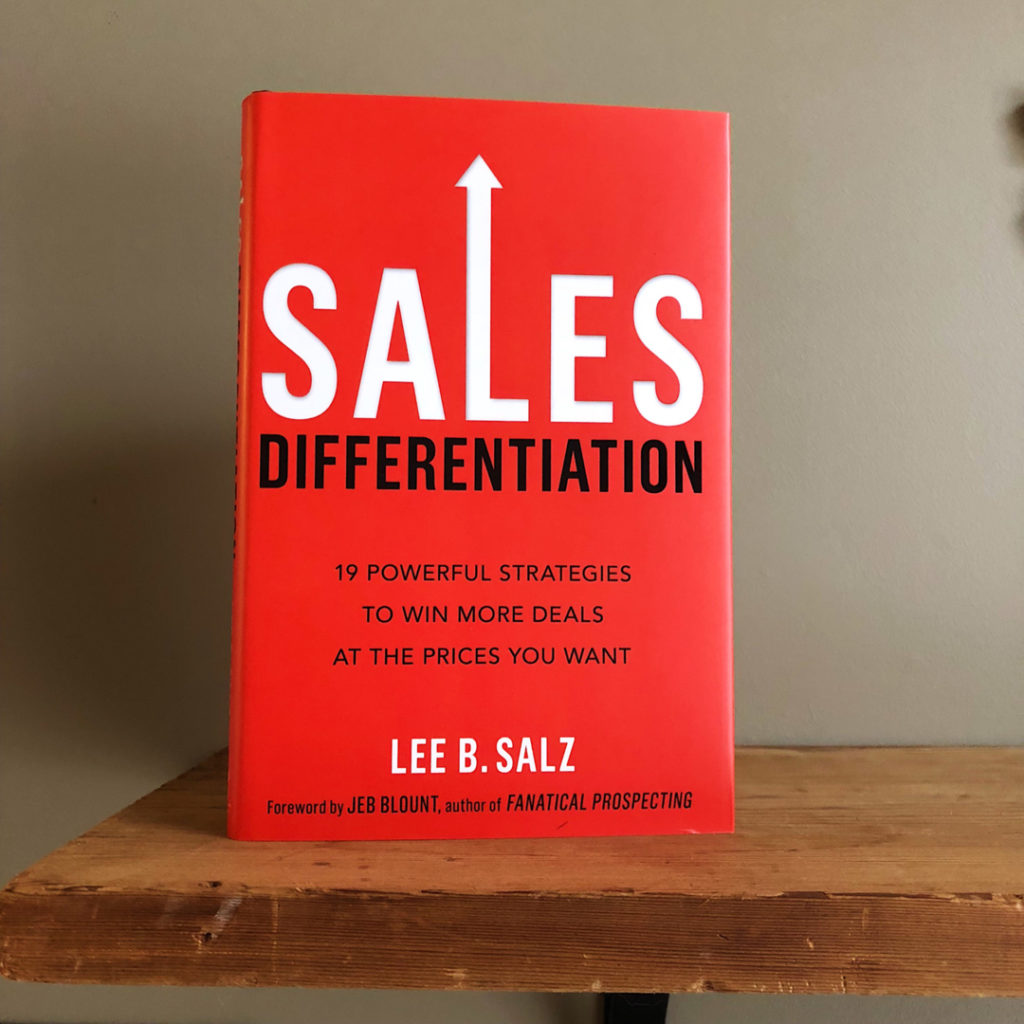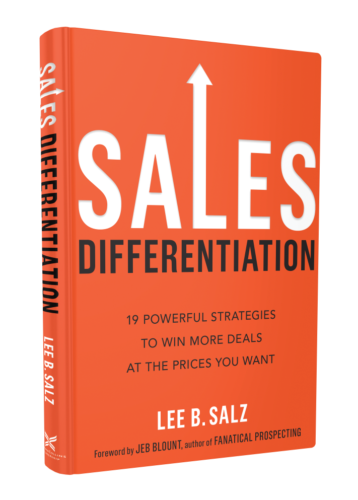Developing a Sales Crime Theory
Excerpt from Sales Differentiation: 19 Powerful Strategies to Win More Deals at the Prices You Want by Lee Salz

Sales Differentiation Concept #11
A Sales Crime Theory differentiates you by answering this question: Why should this buyer want to talk with you right now?
It’s the middle of the night and there is a pounding on your front door. Bam! Bam! Bam! You scramble to put on your robe and rush downstairs to see who’s there. You peer out the window and see flashing lights. It’s the police! “We want to talk with you about a crime that was just committed.”
How did the police come to arrive on your doorstep? Did they knock on every door in the neighborhood until they found someone to talk to?
Of course, they didn’t. They followed the trail of evidence and developed a crime theory. That crime theory led them to you for a conversation right now.
Could you imagine if the police force’s crime resolution strategy was to go to every home and say “Hi, did you commit a crime today? If so, can you tell me which one, so we can close the case?” No suspects would ever be captured.
Making Buyers Miserable
While this isn’t the police’s strategy to find suspects, it is a very common sales practice. Salespeople blindly make calls hoping to find suspects that they can turn into prospects. If they can’t find suspects, they can’t turn them into prospects. No prospects means no sales. That’s a sequence of events that even makes sense to Inspector Clouseau.
Not only is this approach painful for salespeople, it’s a miserable experience for Decision Influencers. They receive random calls from salespeople saying what they have to offer is “best,” who know nothing about them or their companies, and who fail to engage them in a meaningful way. Some polite DIs will tell you they are happy with their current provider and end the call. Others slam the phone down in disgust.
Believe it or not, most DIs have a target on them—a way to engage them such that they’ll want to learn more about what you have to offer. Unfortunately, most salespeople handle prospecting calls in much the same way kids play pin the tail on the donkey: They blindly wander hoping to hit the target. It rarely worked at birthday parties and it rarely works in sales.
The Sales Crime Theory
What if we applied the police’s crime-solving strategy to sales? Before attempting to have a conversation with someone, develop not a crime theory, but rather a Sales Crime Theory that gives a specific reason why we are contacting this buyer for a conversation right now.
To find that reason, ask yourself the foundation question of a Sales Crime Theory.
Why should they want to talk with you right now?
Many salespeople see this question through a different lens and ask themselves why they should talk with this buyer. One of the goals when prospecting is to gain DI engagement. We are trying to motivate them to explore a relationship with us. Asking yourself why you should talk with them, instead of the other way around, places the focus erroneously on you. The focus, however, should be on what would motivate this person to explore what you have to offer.
Activity Quantity versus Quality
Some see sales as merely a numbers game. They think that if you make enough calls you will be successful in sales. I argue that quantity alone does not assure success. Activity quantity is certainly important, but the quality of each call is also a necessity. Developing a Sales Crime Theory before making calls adds a qualitative element to your prospecting activities.
People no longer tolerate being the sales call of the day, nor do they allow you to come into their offices asking what it is they do, in search of a problem to solve. Their expectation is that before you call them, you’ve done your homework and have a reason why they should have a conversation with you today.
That may be what buyers expect, but few salespeople do it. It is expected that salespeople will hear countless “no’s” before getting a single “yes.” That failure is exacerbated by poor sales prospecting strategies. Thus, quantity of calls alone won’t get you where you need to be. The quality of each interaction in the buying process ultimately determines your sales fate.
Perils of Voicemail Messages
In today’s technological age, salespeople are most likely to get voicemail during most of their prospecting efforts. If you are lucky enough to reach someone on the phone, you need to make the most out of that interaction, which is exactly what a Sales Crime Theory helps you do.
With a Sales Crime Theory developed, you have the information needed to craft a compelling voicemail message. Salespeople often tell me that leaving voicemail messages frustrates them. “No one calls me back!” They look to me for pearls of wisdom to make their phone ring with return calls.
Rather than give an answer, I ask them why that person should call them back.
“What message did you leave to help that person recognize he should want to talk with you now?”
Unless what you have to offer cuts a prospect’s costs by an inconceivable amount, the standard voicemail message—leaving your company name, your name, and your phone number—won’t lead to a return call.
However, by using Sales Crime Theory evidence, you can craft an effective message that either leads to a return call or prepares a DI for a conversation with you.
Finding Sales Crime Theory Evidence
Imagine you are reading the current issue of your local Business Journal. You come across an interview with the CEO at XYZ Manufacturers. During the interview, the CEO shares his initiative for next year, which is to make his company more efficient and reduce costs. The efficiency and cost reduction initiatives provide you with Sales Crime Theory evidence.
If WHAT you sell addresses those two points, you have what you need to connect the evidence to your solution and formulate a Sales Crime Theory that is communicated in HOW you sell.
Putting Together a Sales Crime Theory
Based on the evidence you gather, develop a compelling message, one for the target entry point for the account, based on what you have to offer that helps the person recognize he should want to talk with you right now. For example:
If you keep your ear to the ground with your prospects/clients and follow the news, you can readily find evidence relative to your competition. If you hear about multiple quality issues with the same providers, you can use that evidence to further investigate and formulate a Sales Crime Theory. In this case, ask yourself how quality issues affect clients. Who do those issues impact? Why is the quality issue important?
The answers to those questions give you what you need to determine who to contact and what the approach should be to help that person recognize he should want to talk with you now. An approach could be:
“Good morning, Mr. Jones. I understand you are the head of manufacturing. The reason for my call is that we have had several manufacturing leaders of late contact us for help with improving quality. Given that is a responsibility of yours and that we help manufacturing leaders like you improve quality, perhaps we should have a conversation. What is your availability next week to explore ways we can help you improve quality?”
Notice that I never bashed the competition. I didn’t mention them at all. What I did do was plant the seed that his manufacturing colleagues are looking for ways to improve quality and are contacting us for help. I left the door open for him to share if he is having quality issues. I also helped him visualize the synergy between his goals and what we offer. Rather than push for a meeting, I used words like “perhaps” and “conversation” to come across in a nontraditional salesperson fashion, which is different than what the competition would have done.
Why You Are Contacting Them Now
The Sales Crime Theory gives purpose to your outreach. Sometimes you will share the evidence you found like I did in the first example with the Business Journal. In other cases, that information is kept to yourself as I did in the second example.
Here are several examples of Sales Crime Theory evidence:
ABOUT THEM
- They have public relations news.
- They have new locations.
- They have a new product or service launching.
- Their company has a new corporate objective.
- They were acquired.
- They hired a new executive.
- Changes in regulation impact their business.
- There’s a new trend—a best practice that can help them.
- There are provider consolidation opportunities that can make them more efficient.
- They are being sued.
- They acquired a company.
- They won an award.
- The have a new initiative or directive.
ABOUT YOU
- You have new locations.
- You are the new salesperson in the territory.
- You were acquired.
- You have clients in the same vertical industry.
- You are offering a new product or service.
- You have a new solution to an old problem.
And here are several ways to find Sales Crime Theory evidence about them:
- Research the prospect company for news and announcements.
- Research their competitors in search of advantages their competitors have over the company you plan to contact. Look for aspects you can help them address.
- Research their industry to learn trends and best practices through their associations.
- Research your industry for upcoming changes to regulation or new best practices.
- Research your competitors for hiring news, acquisition news, and word on the street about performance.
- Research Decision Influencers to find out their concerns and goals. Connect those to the solutions you offer.
Most of this research can be performed online through direct visits to websites and Google searches. Google Alerts are an easy, free way to receive Sales Crime Theory evidence right in your inbox. Search “Google Alerts” in Google and you will find directions to easily set these up. You can monitor your competitors, industries, people, etc. If you aren’t using these, you are missing out on a great information source.
Keep reading! Download the first 3 chapters of Sales Differentiation.
By submitting your email address, you understand that you will receive email communications from HarperCollins Leadership, a division of HarperCollins Focus (501 Nelson Place, Nashville, TN 37214 USA) providing information about products and services of HCL and its affiliates. You may unsubscribe from these email communications at any time. If you have any questions, please review our Privacy Policy or email us at yourprivacy@harpercollins.com.

Sales Differentiation
Order today:








